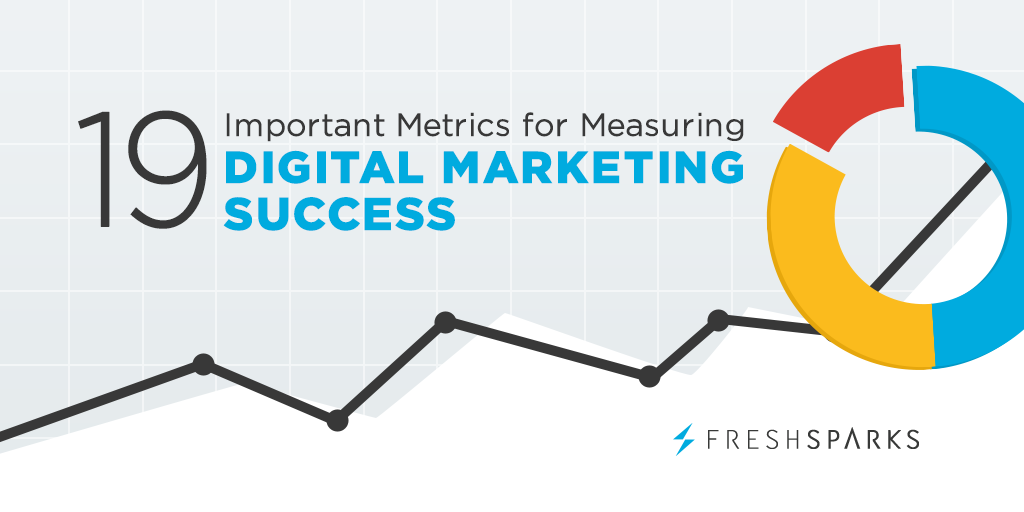
Get on a path to finding ROI for your brand. Learn what digital marketing metrics matter for tracking success with your business growth!
How are digital marketing metrics effectively measured for success with brand growth? You’re probably thinking: leads and sales.
But a successful marketing campaign can be determined by much more than just those types of conversions!
Ask yourself:
Do you want more organic traffic to your website?
How about a broader reach on social media?
Or, a higher email click-through rate?
These are all valid goals to aim for and are backed by analytics data you can gather over time. As you’ll soon learn, there are a number of important digital marketing metrics examples to track and guide your campaigns, both for sales conversion and brand awareness.

Source: MDirector and Insight Venture Partners
Whenever you are focusing on your marketing efforts, think about this:
It’s important to build a brand, not just a business.
Branding, in essence, is creating a distinct feeling and experience for your customers.
You might be wondering:
Well, how do I measure something so touchy-feely?
Branding needs a strategy, to communicate who you are and why people should care.
It’s marketing that will execute on that brand strategy, and how you build awareness for your brand. Especially through digital marketing, these days.
And digital marketing campaigns can certainly all be tracked with digital metrics. Therefore, so can your branding efforts!
But in order to build a strong brand that can scale effectively by leveraging digital marketing tactics, the following questions have to be answered first in a strategic way:
- What problem do you solve? How you do it differently? What is your purpose?
- How does your business stand out over the competitors?
- Have you laser-focused on a specific audience who has the same values?
- Is your brand voice distinct, consistent, and recognizable?
- Do you have a clear and compelling brand messaging to support your content?
>> You can learn how to do all of this brand strategy stuff here.
Now:
Depending on your particular business plan and marketing efforts, some digital marketing metrics may be more important than others.
Narrowing down your reporting to include the most relevant key performance indicators (KPIs) will reflect what digital marketing success looks like for your brand.
This in-depth article will cover:
- How to measure digital marketing success for branding
- The website traffic metrics that matter most
- Other important digital marketing analytics to watch
- Resources to help you improve your marketing metrics
You’ll find out which digital marketing metric examples that brands use to determine website success. And, which of these digital metrics is especially important to branding campaigns.
Ready to dive in?
How to Measure Digital Marketing Success
Before you can determine if your digital marketing campaign is a success, you need to set objective, achievable goals.
Starting With A Goal
Much of your online strategy is born from your goals.
Goal setting ensures you have something to strive for. What’s more, it provides a guideline for the key digital marketing metrics you’ll use to measure the success of one or more campaigns.
I’ll put it another way:
You really can’t measure success without goals!
That fact holds true no matter what you’re attempting to measure. From digital marketing success to personal financial success, without goals you are limited to two basic analyses:
“I seem to be making some progress.”
Or:
“This doesn’t look like it’s working.”
Kind of vague, huh?
Take a look at the sample below from Sprout Social. It shows five distinct social media metrics and a detailed plan for how the company intends to achieve them.
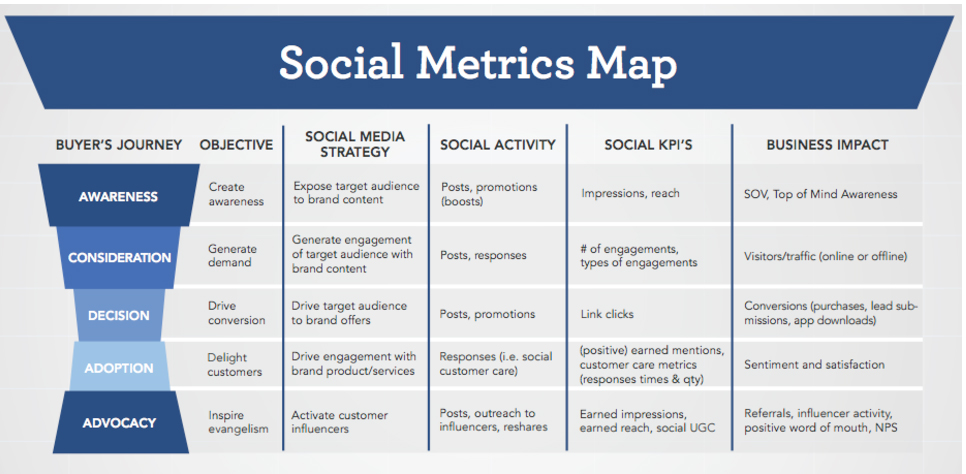
Your digital campaign will have more than just a social media element. However, this template offers a nice overview of how you can set goals for anything—and during any point of your marketing funnel.
SEE ALSO: 10 Ways to Set Realistic Social Media Goals for Your Business
There are a few key details you’ll want to include above and beyond what you see in the diagram.
I’ll break down exactly how to set the goals you can use when measuring digital marketing KPIs:
Commit to a Time Frame
Accountability is a large, if not the largest, part of reaching a goal. Whether you have 5 days or 5 months, you must include a concrete time frame.
Determining the time frame for your digital marketing campaign goals will help create a sense of urgency as well as accomplishment.
A time frame can also set parameters for comparison when you run marketing metrics reports for month-over-month or year-over-year progress.
Determine Success Factors
Let’s say your goal is to earn 500,000 impressions from social media campaigns and drive 10,000 new visitors to the website. Those are two excellent digital marketing success factors.
The key to this step is determining a quantifiable result to achieve—real numbers that could be an educated guess or based on a pattern of growth.
Keeping a time frame in mind, be sure to determine how long you have to reach this milestone. It can be one month or 12 months, depending on the effort behind the digital marketing campaign.
Provide Specific Details
When you think about digital marketing KPIs, there should be numbers assigned to them.
Simply saying, “expose target audience to brand content” isn’t enough. Set yourself up for success by providing as much detail as possible.
Being specific with details will better prepare you to execute your campaign by serving as a roadmap. Furthermore, it helps you pinpoint what works and what doesn’t when you’re ready to measure efficacy.
Create a Marketing Measurement Template
Once you have selected the key digital marketing metrics for your campaign, putting together a marketing measurement template is easy and provides valuable insight.
This document will serve as a guideline. It is something you can use (and modify as necessary) with each campaign.
A marketing measurement template might include things like:
- Your initial goal(s).
- An overview of what happened during the campaign (your marketing metrics will go here).
- Things that worked the best, and what you learned from them.
- Things that didn’t work so well, and what you learned from them.
As a refresher, this graphic from Perdoo explains concisely how to write SMART goals for any project or campaign:
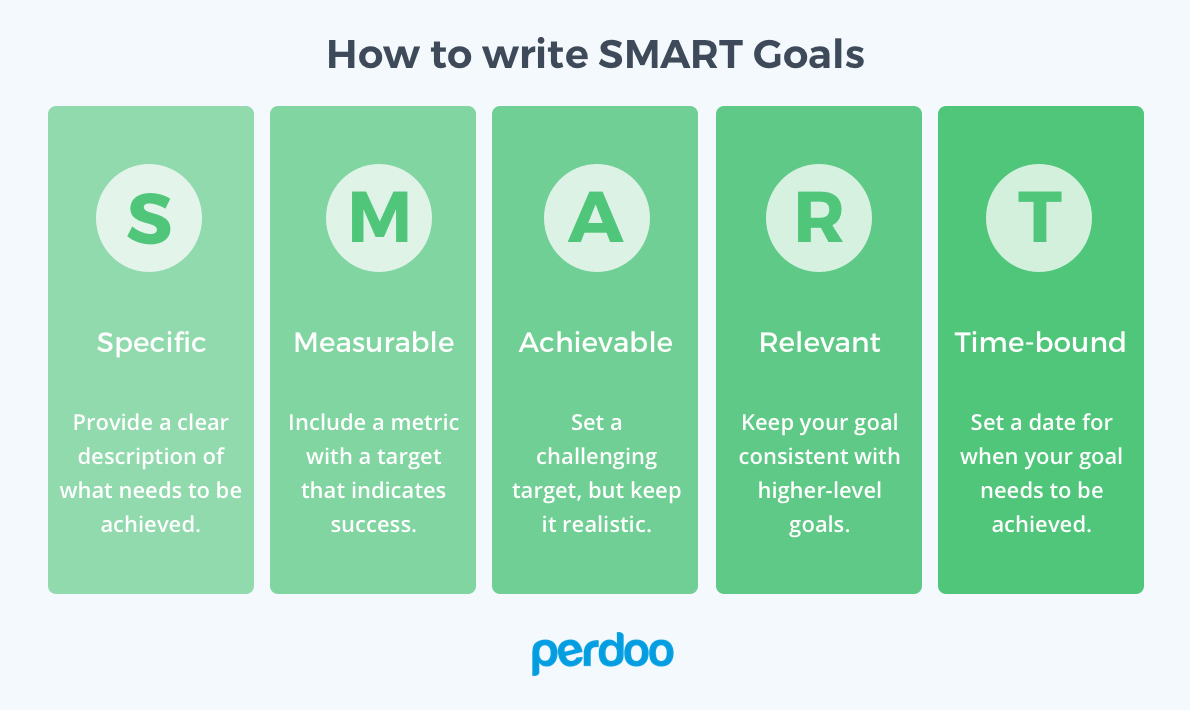
Now you’re prepared to set goals before executing a successful digital marketing campaign for your brand.
Let’s take a look at the exact marketing campaign metrics you will use to measure the success of those goals.
19 Digital Marketing Metrics You Need to Track
When it comes to measuring digital marketing success, there are seemingly endless digital marketing metrics examples. Below is a compilation of the most important ones you’ll need to consider.
Not all of these digital marketing KPIs may be relevant to your particular business goals, but it’s a starting point on the road to finding ROI (return on investment)!
Website Traffic Metrics That Matter for Growth
These first 10 items outline the website traffic metrics that matter most for success with digital marketing. Do you have Google Analytics installed on your website? You’ll need it, or something similar in order to track this type of data.
1. Overall Website Traffic
What do most companies measure to determine the success of their websites?
Traffic.
Your website serves as your home base, and the face of your brand. Therefore, all of your digital marketing efforts will likely focus on driving traffic there. Individual campaigns may focus on list building or increasing social media reach, but the ultimate goal of that activity is to send more traffic to your website over time.
Because of this, measuring website traffic metrics regularly will provide you with a number of insights such as which campaigns are working and when.

Source: Digital Inspiration
If at any point you see a steady decline in traffic while still conducting consistent marketing efforts, consider troubleshooting your website. You may find broken links, a Google Algorithm penalty, or other technical issues deterring visitors.
Tips for sending more traffic to your website:
- Optimize all pages on your site with relevant keywords
- Consistently publish in-depth content on your blog
- Promote your content on social media channels
- Create targeted ads to a landing page with an offer
More resources to help you improve this website traffic metrics:
- 40 Blogging Tips for Growing Traffic to Your Website
- How to Increase Your Website Traffic Without SEO
- 27 Ways to Increase Website Traffic in 2018
- The Best Tactics to Drive Traffic To Your Website
2. Traffic by Source
This useful website traffic metric sheds light on exactly where your website visitors are coming from.
With the myriad of marketing platforms available and limited time to capitalize on all of them, the Traffic By Source metric is one to watch.
Use it to determine which sources are winners, and which ones need a little more attention. Or, use it to narrow down where you’ll spend your valuable time creating content.

Here are the four main website traffic sources tracked by Google Analytics:
- Organic Search: These users clicked a link on a search engine result that brought them to your website.
- Direct Visitors: These users typed your URL directly into the search bar, or perhaps have it bookmarked and returned to visit.
- Referrals: These users were sent to your website when they clicked a link from another website.
- Social: These users came to your website after finding your social media profile or content posts.
3. New Visitors vs. Returning Visitors
The value of this dual metric is that it helps you determine how relevant your website content is over time. Multiple visits can indicate you are providing information that people find so valuable, that they keep coming back.
As you release new content on a regular basis (think: blogs), you can review your New vs. Returning Visitors marketing metric to see how any given content piece is performing.
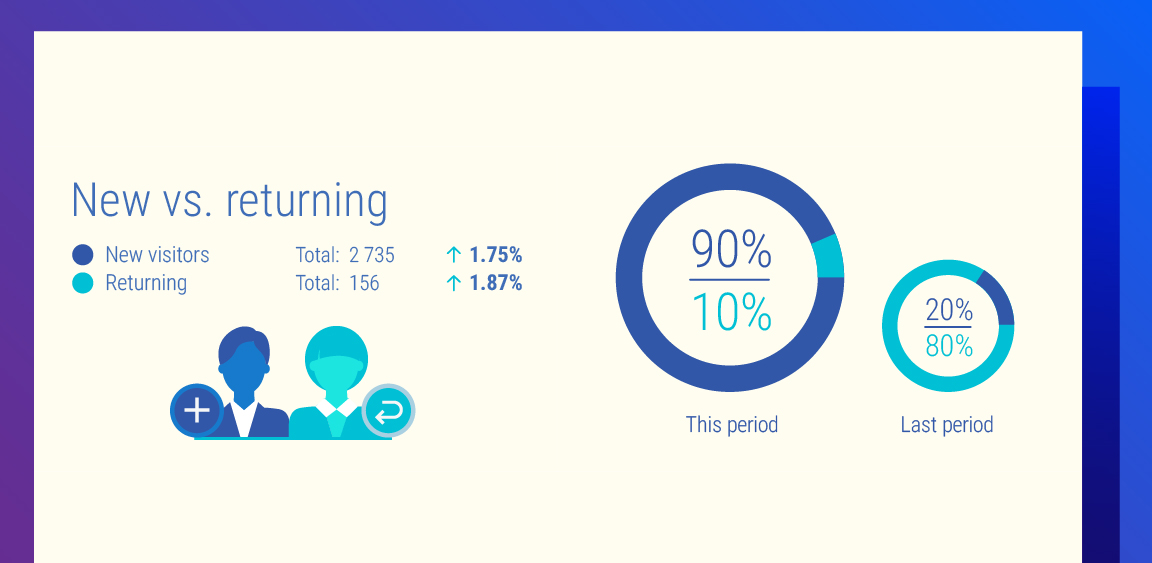
Source: whatagraph.com
Simply put:
If you’re looking to drive more organic traffic to your website, New Visitors may be of importance to you.
If you would like to measure how many people come back to browse and consume info, the Returning Visitors website traffic metric is important to note.
Tips for increasing new and returning visitors:
- Create and publish valuable blog content that can be found organically via search engines
- Use Twitter to promote blog posts, and add 1-2 relevant hashtags
- Send an email blast to your subscribers after a new piece of content is published
More resources to help you increase visitors to your site:
- How to Start a Successful Blog For Your Business
- 3 Tips to Increase Returning Visitors
- 4 Tactics to Bring More Visitors to Your Website
- How to Attract Visitors to Your Site
4. Sessions
Sessions refer to the number of visits your website receives. Google specifically counts this in 30-minute increments, meaning it triggers this website traffic metric only once every half hour for each individual user.
Think of Amazon, as an example:
Users may trigger a session in the morning to shop, and then visit again later in the day to add something new to their cart. Each of those are considered unique sessions.
5. Average Session Duration
Depending on your website’s function (informational, ecommerce, etc.) or the industry, the time on site metric can vary in its relevance to your campaigns.
A study by Brafton found these average session duration numbers by industry.
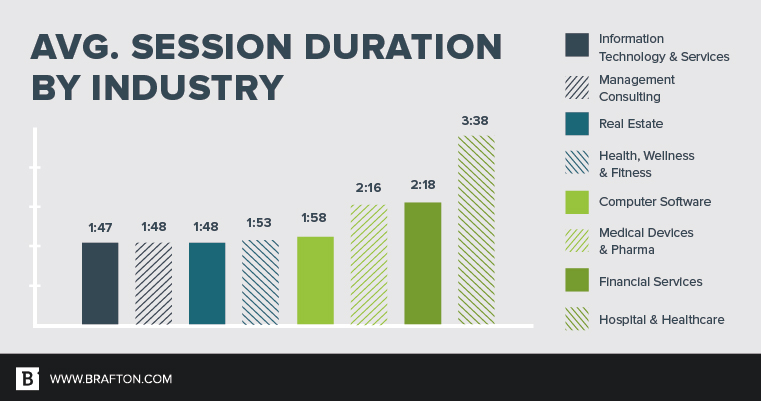
Average Session Duration is a general indicator of how long visitors spend on your site entirely. This helps you to understand how your site performs from a user experience (UX) standpoint.
- Is your website easy to navigate?
- Are users finding what they’re looking for quickly?
- Is the content valuable and worth reviewing at length?
Average Session Duration (time on site) can help answer these questions and many more.
Tips for increasing a visitor’s time on page:
- Add a video to your content
- Use Bucket Brigades to help readers stay engaged
- Increase the readability of your copy (larger fonts, more white space)
More resources to help you improve average session duration:
- Dwell Time: The Most Important Metric You Are Not Measuring
- 11 Hacks to Increase Visitors’ Average Time Spent on Site
6. Page Views
This is the total number of pages viewed. A user who repeatedly visits the same page will trigger this marketing metric, so it’s the broadest of all page-related measurements for digital marketing success.
However, it’s one of the most important website traffic metrics.
It’s relevant to know how many pages are visited on your website in a given time period. This helps you to understand if your entire site is of value or if only certain pages are.
7. Most Visited Pages
To further determine which areas of your website are most valuable, look at this metric. You can find it in the “Behaviors” section of Google Analytics.
The Most Visited Pages metric uncovers all sorts of information about exactly where your site’s visitors are going and for how long. For a deeper analysis, check out the Behavior Flow.
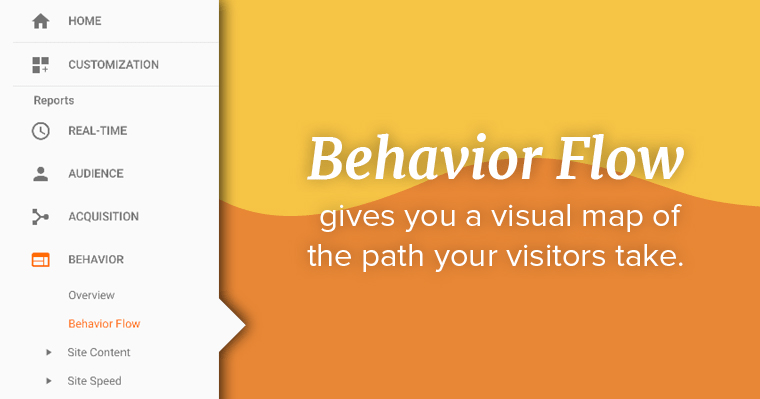
Source: Roadside
8. Exit Rate
Here’s a marketing metric that is very specific and reveals quite a bit about your website design and user experience.
If your campaign is meant to drive new users to your website for a more general “learn more” branding effort, the Exit Rate metric will show you exactly where they left after they reviewed your content.
Unlike Bounce Rate which triggers when someone views only one page, Exit Rate tells you where the user lost interest after spending some time exploring.
Make sure they don’t lose interest in your brand!
9. Bounce Rate
Different from Exit Rate, the Bounce Rate metric is the percentage of people who leave (bounce away) from your website after viewing only one page.
This metric can help reveal that visitors may be leaving because:
- The site takes too long to load
- They did not immediately find what they were looking for
- They found relevant content but were not compelled to click further
- An error page loaded
Unless your website is set up to send users to a separate URL for conversion, you should look to the Bounce Rate number to determine if your campaign is effective.
An overview of average bounce rates for certain environments is noted below, in a chart by Kissmetrics.
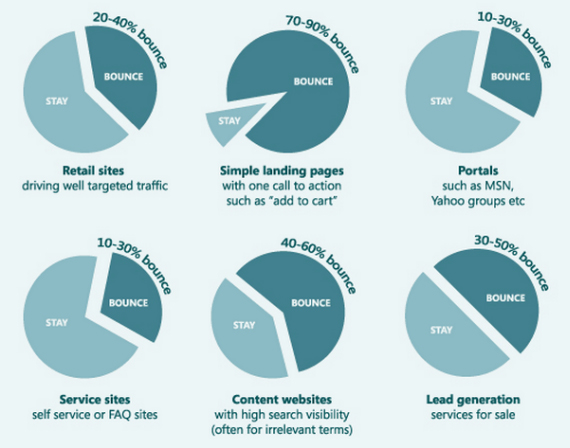
Source: CrazyEgg
If you are marketing a new product but your link sends users to the website’s Home page, you’re likely to have a high bounce rate. Therefore, combat this by sending them to a page that is highly relevant to the path you want them on.
Tips for reducing bounce rate on your website:
- Decrease your page load time
- Add internal links to your page copy
- Include images or other visuals in your content
- Use a compelling call-to-action
More resources to help you reduce bounce rate:
- 13 Tips to Reduce Bounce Rate and Improve Conversions
- Understanding Bounce Rate In Google Analytics
- 11 Easy Ways to Reduce Your Bounce Rate
10. Conversion Rate
Google Analytics can help measure the number of conversions made on your site.
However, conversions may mean different things depending on the campaign.
For example, they could be:
- an actual sale,
- a subscriber,
- a completed download,
- a lead entry,
- and more.
Oftentimes, the number crunchers only look to this digital marketing metric to determine if your campaign is effective. However, it’s only one piece of the puzzle and should be part of your overall digital marketing strategy.
Resources to help you improve your conversion rate:
- The 13 Most Effective Ways to Increase Your Conversion Rate
- 28 ECommerce Conversion Rate Optimization Tactics
There you have the top ten website traffic metrics that matter for marketing. Are you tracking some, or all of them?
Guess what: there are even more key digital marketing metrics you need to measure!
Below, take a look at some others related to your online strategy such as:
- Social media metrics
- Advertising metrics
- Email marketing metrics
Other Digital Marketing Metrics That Matter
11. Impressions
Which marketing metric is especially important to clients who are running a branding campaign?
Impressions!
Sometimes confused with reach, an impression is the larger overall number of views your content or advertisement receives.
Your content on social media or a pay-per-click ad may be shown multiple times to the same person. Each time is counted as an individual impression. As a result, this number will always be higher than reach because the reach metric is only triggered once per user.
12. Social Reach
The posts you make on your social media platforms are meant to reach a wide number of users. This social media metric tells you exactly how many people were reached (i.e. saw your content).
Now, the number of people reached is always much larger than the number who engage.
A benchmark goal is to see 2-5% engagement based on your overall reach.
Tips to increase your social media reach:
- Fully brand all your social media profiles
- Post curated and original content consistently
- Engage with your community
More resources to help improve social reach:
13. Social Engagement
Social Engagement reflects the total number of interactions made on any given social media post.
This could mean:
- Clicks
- Shares
- Likes
- Retweets
- Comments
Engagement is the yardstick by which to measure all of your social media success.
You can pay for all the others, but engagement is only earned when a user chooses to interact with your content. Because of this, you can easily rank your content types based on how much engagement they receive. This helps to guide your future content creation!
More resources to help improve this social media metric:
- 6 Key Elements of Using Social Media For Customer Service
- 15 Ways to Increase Social Media Engagement Quickly
- How to Increase Social Media Engagement: A Guide For Marketers
14. Email Open Rate
If you’re list building with your website (and you should be), this is one of the most important email marketing metrics you need to watch.
Your Email Open Rate measures the number of people who open your email campaign as compared to the overall number of those who received it.
High open rates indicate:
- Properly segmented list
- Attractive subject line
- Appropriate send time
Low open rates tell you at least one (if not all) of those factors above are lacking.
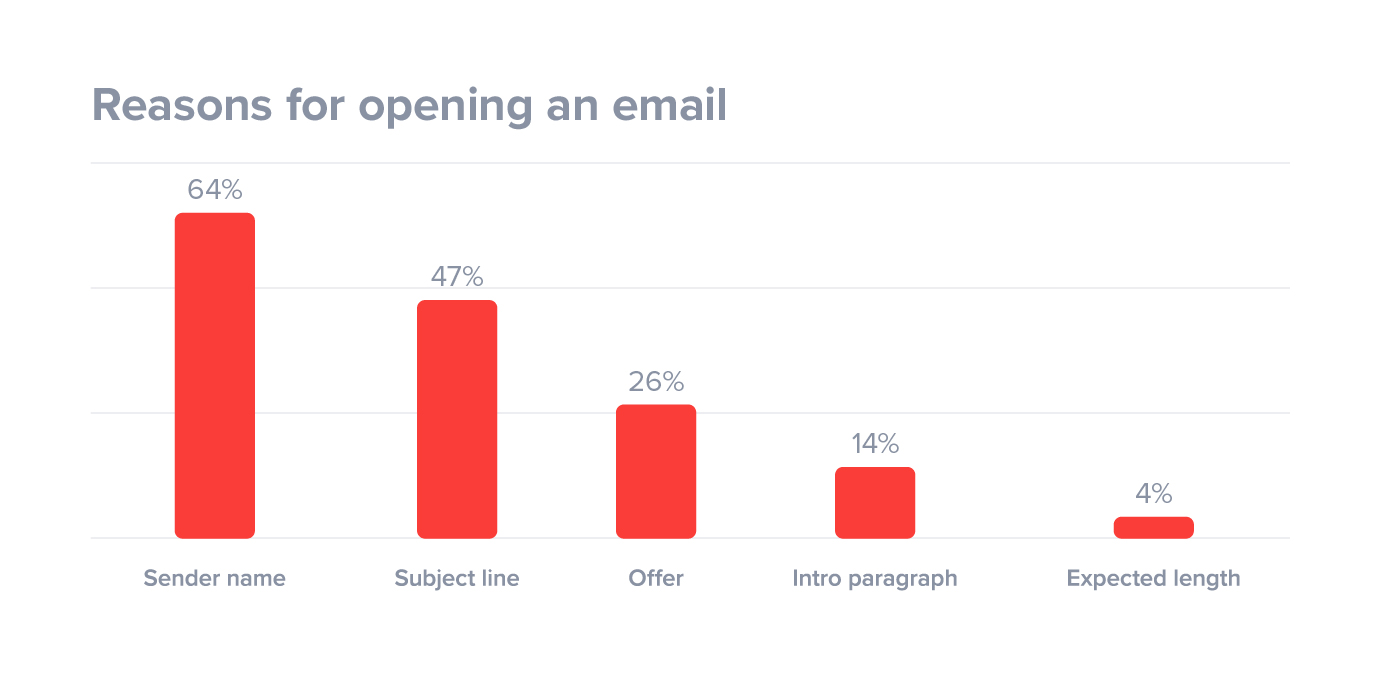
Source: SuperOffice
Resources to help you improve email open rate:
15. Click-Through Rate
The Click-through Rate (CTR) can be used as an email marketing metric as well as a paid advertising metric. Clicks on email blasts are often some of the highest conversion-drivers across the board.
Your CTR as it relates to pay-per-click helps to determine your relevance score and affects your Cost Per Click.
Resources to help you improve click-through rate:
- Improve Your Email Click-Through Rate With These 14 Simple Tweaks
- 5 Psychology-Backed Ways to Improve Your Email Click-Through Rate
16. Cost Per Click
Cost Per Click (CPC) applies to both pay-per-click marketing and a number of social media platforms that offer the clicks-to-site ad type.
These online advertising metrics reflect the amount you pay for each individual click a user performs. This is relevant as it directly relates to your overall marketing budget in this area. Your budget can only go so far; the lower your CPC, that farther it goes.
17. Cost Per Conversion
Cost Per Conversion relates completely to your individual business model, and often to your individual online marketing campaign. As I mentioned previously, not every marketing metric matters to every campaign. This might be one to leave off if you aren’t converting sales directly online.
However, if you’re running an ecommerce website where users can add something to a cart and convert there, CPC is a must-track metric. Simply put, these digital marketing analytics tell you how much it costs to convert a site visitor into a sale.
18. Cost Per Acquisition
Your Cost Per Acquisition (CPA) is only relevant when you have returning customers. This doesn’t just apply to subscription-based businesses or even ecommerce sites. Consider how a private golf community calculates CPA knowing that their members pay monthly dues.
Understanding the lifetime value of a customer helps you back into the proper amount you should spend to acquire a new one.
19. Overall ROI
The return on investment marketing metric should come as no surprise as it serves as a true baseline for success. Basically, ROI equates to how much you spent (investment) vs. how much you earned (return).
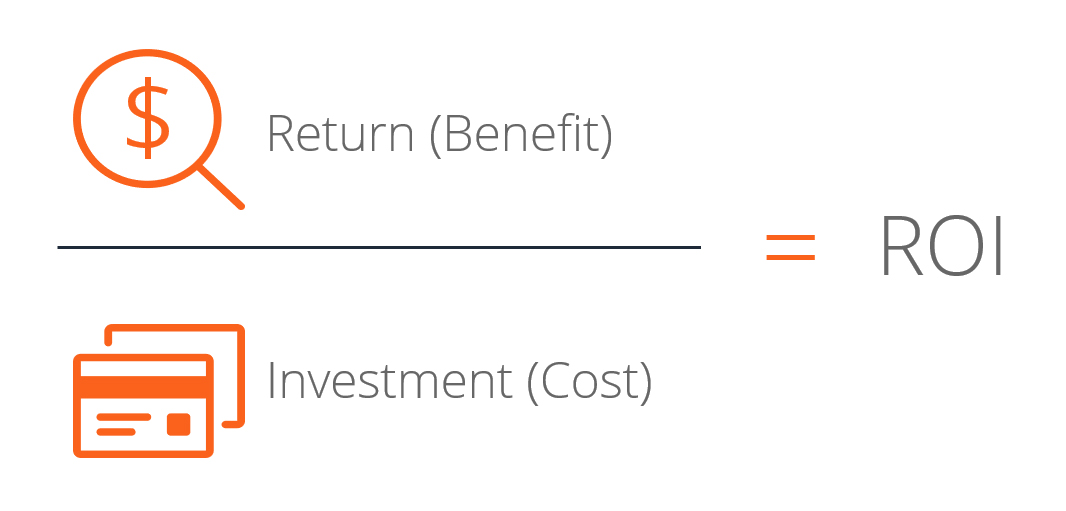
Source: Corporate Finance Institute
It’s easy to lose track of exactly what you’re spending on marketing because we often fail to count hours of effort. Ensuring you properly calculate your online marketing campaign’s ROI will be the key to determining if it was an overall success or not.
Digital Marketing Metrics For The Win
If you’ve made it this far, you are now well-equipped with how to measure your digital marketing success by using the right data to track the success of brand building.
Remember these key factors when you’re ready to create, execute and measure the next campaign for your online strategy.
First and foremost, set goals for your digital marketing campaigns.
Then, select marketing metrics of value based on those goals.
Choose from these:
- Overall Website Traffic
- Traffic by Source
- New Visitors vs. Returning Visitors
- Sessions
- Average Session Duration
- Page Views
- Most Visited Pages
- Exit Rate
- Bounce Rate
- Conversion Rate
- Impressions
- Social Reach
- Social Engagement
- Email Open Rate
- Email Click-Through Rate
- Cost Per Click
- Your Cost Per Conversion
- Cost Per Acquisition
- Overall ROI
Finally, always use the analysis of your incoming digital metrics data to guide the next steps.
What other key digital marketing metrics examples should we include for measuring success with brand growth? What is your best KPI to date?
Share with us in the comments below!
FreshSparks is a branding agency specializing in brand strategy, brand identity, and brand marketing. We can help you with branding and marketing your business successfully – based on data! Contact us to learn more.
If you liked this post, please share!

I got good info from your blog, a Great lineup. We will be linking to this great article on our site. Keep up the good writing.
Thanks for sharing such a great information it will use full to us.
Hi, nice post and thanks for sharing the information about digital marketing strategies.
Great round up. My agency is also using Admers for the deeper overall look to the marketing funnel. It lets you easily compare date from different channels and see synergy between them. https://admers.com/
Valuable Stuff. I Would also suggest https://firstdigiadd.com/blog.html
I’m grateful that I came across this very informative article about digital marketing, this is very helpful, thank you. I hope many digital entrepreneurs and marketers can get a chance to read this. I would also recommend seeking guide and advice from skilled digital marketing services provider to help you grow your business.
Good, best information helpful to everyone or specially for Digital Marketer.
Nice content! Thank you for sharing!
You’re welcome, Michelle! Glad you found value in it.
I am in a marketing communications class. The information you provided is valuable and useful in the course. You make it very easy for even a newcomer to marketing to understand. .
Great feedback, Cesar! Hope to hear more from you again.
I know nothing about digital marketing and trying to learn, your articles are super informative and to the point
thanks
You’re welcome, Yasmine! So glad that you have found value from them. Hope to hear more from you here. -SG